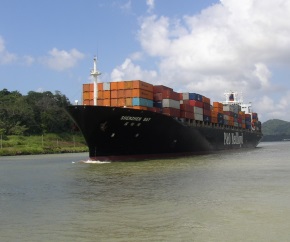Rebound in sight as China’s gasoline exports hit five-month low

China’s gasoline exports in August slid further to hit five-month lows, extending the downward trend that started in the previous month, as steady demand at home, a squeeze in local supplies and lower gasoline cracks discouraged refiners from shipping out plentiful cargoes.
But analysts said exports could recover in September as gasoline cracks had recovered from the lowest level in more than 32 months that the Asian market witnessed in early July.
Gasoline exports fell to 672,347 mt, or 184,353 b/d, in August, which was 30% lower than the 966,528 mt in July, and 41% lower than the historical high of 1.1 million mt, recorded in June, the latest data from the General Administration of Customs showed.
Exports in August were also lower than the average of 212,143 b/d registered in the first eight months of the year. But they were nearly 44% higher than the 467,000 mt in the same month of last year, signaling that the year-on-year trend of rising gasoline outflows was still intact.
“More travelling activity by the end of the school summer holiday period led to more gasoline consumption, after the floods in June and July,” said a Shanghai-based analyst, indicating higher domestic demand.
The government-backed Xinhua news agency said that, as domestic demand remained buoyant in August, it led to a 1.5% month-on-month decline in gasoline stocks by the end of August.
In addition, supplies in eastern China were tight because of heavy maintenance, as well as the output restrictions imposed during the G20 summit in Hangzhou that started end of August, refining sources in Shanghai said.
“Thin FOB Singapore 92 RON gasoline cracks also discouraged exports from China,” said a trader with a state-owned oil company.
In early July, when exporters were finalizing export plans for August, the benchmark FOB Singapore 92 RON gasoline price’s premium to front-month ICE Brent futures witnessed a downward trend — falling to $1.66/b, the lowest level in over 32 months, on July 8.
Although the crack has been recovering gradually since then, it has remained at a relatively lower level, with the monthly average at $4.71/b, S&P Global Platts’ data showed.
So far this year, the crack has moved between $1.66/b and $17.02/b. It closed at $8.85/b on Friday.
“With the recovery in the crack, we expect China’s gasoline exports this month to recover from August,” said a Beijing-based analyst, commenting on the export outlook for September.
LOWER OUTPUT
Meanwhile, sliding gasoline exports were also in line with China’s declining output since June when the country’s refiners produced 3.12 million b/d of gasoline, while volumes eased to around 2.9 million b/d in July and August, data from the National Bureau of Statistics showed.
Cargoes for gasoline exports are mainly supplied by refineries holding oil product export quotas.
Beijing regulates oil product exports by issuing quotas to qualified refineries.
Gasoline exports recorded by customs in Hohhot, Shenyang, Dalian, Changchun, Nanning and Kunming dropped by about 45% to 227,000 mt in August, from July levels.
Mainly, PetroChina’s refineries export oil products through these outlets. PetroChina accounts for around half of China’s gasoline exports.
Meanwhile, exports recorded by the Xiamen customs also showed a 30.4% drop to 123,000 mt last month, from July levels. Sinochem’s Quanzhou refinery is the main exporter through this outlet.
Sinochem Quanzhou was first granted oil products export quotas late last year and has since become one of the top two suppliers for gasoline exports in China.
The other top supplier is the export-oriented Dalian West Pacific Petrochemical.
For September, Sinochem Quanzhou has plans to lift gasoline export s by 20,000 mt to 145,000 mt, while WEPEC is also planning to increase exports to 171,000 mt, from 137,000 mt in August, according to company sources.
EXPORT FROM INDEPENDENTS
Gasoline exports from independent refineries have been stable since July, despite more new players joining the sector. But volumes by those refiners accounted for lower than 10% of China’s total gasoline outflows.
In August, one more new player, Shandong-based Luqing Petrochemical, sent out its first gasoline export cargo — about 33,000 mt — to Malaysia.
In addition to exports by Dongming Petrochemical and Hongrun Petrochemical, exports by Luqing led to at least 73,000 mt of gasoline exports from the independent refining sector in August, slightly lower than the 75,000 mt recorded in July, according to S&P Global Platts’ data.
This month, Wonfull Petrochemical exported its first gasoline cargo of 10,000 mt, which was co-loaded with gasoline barrels from Sinopec’s Hainan refinery, making it an MR-sized cargo. It was shipped to Singapore.
Market participants said at least 75,000 mt of gasoline exports had been planned by the independent sector for October — 35,000 mt from Hongrun Petrochemical, 20,000 mt from Chambroad Petrochemical and 20,000 mt from Tianhong Petrochemical.
Only two new quota holders in the independent refining sector — Baota Petrochemical and Lihuayi Petrochemical — have not announced any export plans.
“It looks unlikely for Baota to export this year due to their low throughput, while Lihuayi may export if profits would look good,” said a market observer.
Baota holds 30,000 mt of gasoline export quotas, while Lihuayi has 20,000 mt.
Until now this year, the independent refinery sector has been granted total export quotas of 835,000 mt by Beijing.
Source: Platts
HEADLINES
- Do shipping markets want Biden or Trump for the win?
- All 18 crew safe after fire on Japanese-owned tanker off Singapore
- Singapore launching $44m co-investment initiative for maritime tech start-ups
- Cosco debuts Global Shipping Industry Chain Cooperation Initiative
- US warns of more shipping sanctions
- China continues seaport consolidation as Dalian offer goes unconditional